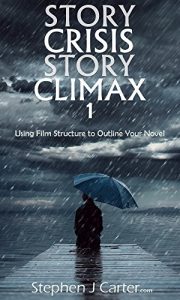Praise for Story Crisis, Story Climax 1
"This book is not only a great read in that the writing is engaging and well-crafted, but it gives practical examples in the form of a guide I plan to keep on hand for future reference. In addition, the author goes over each point, starting with the inciting incident, turning point one, etc. in such great detail, and without overwhelming, I finally understood these principles I've long heard of and studied to some degree yet never fully grasped. That's not the case any longer after reading Stephen Carter's book." – Silvia Villalobos, Author of Stranger or Friend
About the Book
Why spend years learning by trial and error?
Accelerate your learning curve by watching the key elements of story structure at work in a range of films. Whether your focus as a novelist is writing characters or writing action, in this book you'll see the elements of structure in relationship to each other, the story itself, and others of its genre.
Learn the storytelling craft
You'll see how a novelist knits together an inciting incident, turning points, and the closing crisis decision and climax.
How can story arc help you?
See how the process of story change (revealed by the story arc) stretches between two decisions, from Turning Point 1 in Act 1 to the Crisis decision in Act 3. In the former the protagonist commits to the story – to solving the problem. In the latter she commits to the endgame – to confronting the antagonist so the solution is applied.
At a loss for story ideas?
A person (protagonist) faces a problem (Inciting Incident), finds a solution (Crisis decision), acts on that (Climax), and along the way encounters secondary problems (Act 2A Midpoint, Act 2B TP2). Your next story idea could be any such life-problem that seizes your imagination!
You'll discover:
- How to harness events to an Inciting Incident early on that crystallizes the one new problem confronting the hero
- How to guide your characters into theme-tied decisions that cluster into a turning point
- How to enhance the Midpoint's coverage of theme, by providing a vivid contrast before and after that point
- How to layer in what's expected and escalate beyond that in the Crisis Decision, embedding resistance in your hero's response
- How to invest in your story's Climax a test as much for everyone around the hero as for the hero herself
Aspects of genre we'll consider:
- What if you could make your plots dynamic and your characters scary real?
- The one scene no action story can be without
- The only form of drama left standing
- How to show an apocalypse of loss
- When a story leads from error to good sense
- To show the past is to create a different world
- What if the future happened differently?
Writing this book deepened my understanding of story process and led to completing my first novel not long after.
More Praise for Story Crisis, Story Climax 1
"I found this a helpful book in that it gives practical advice to budding authors in creating the overall plot of their works. It uses the world of films as examples, even though the advice is in no way limited to screen-plays. The principles apply equally well to novels. I think every writer needs to understand the concepts presented here, and reading this book is a good way to gain that understanding." – Jim Foxy
"A nice collection of movies broken down into structural forms as laid down by the author." – Juggy
Frame the events of your novel with a cinematic precision, hitting each of the plot points in its story arc. It's a wrap!
Writing Skills
Authorship
Composition and Creative Writing






